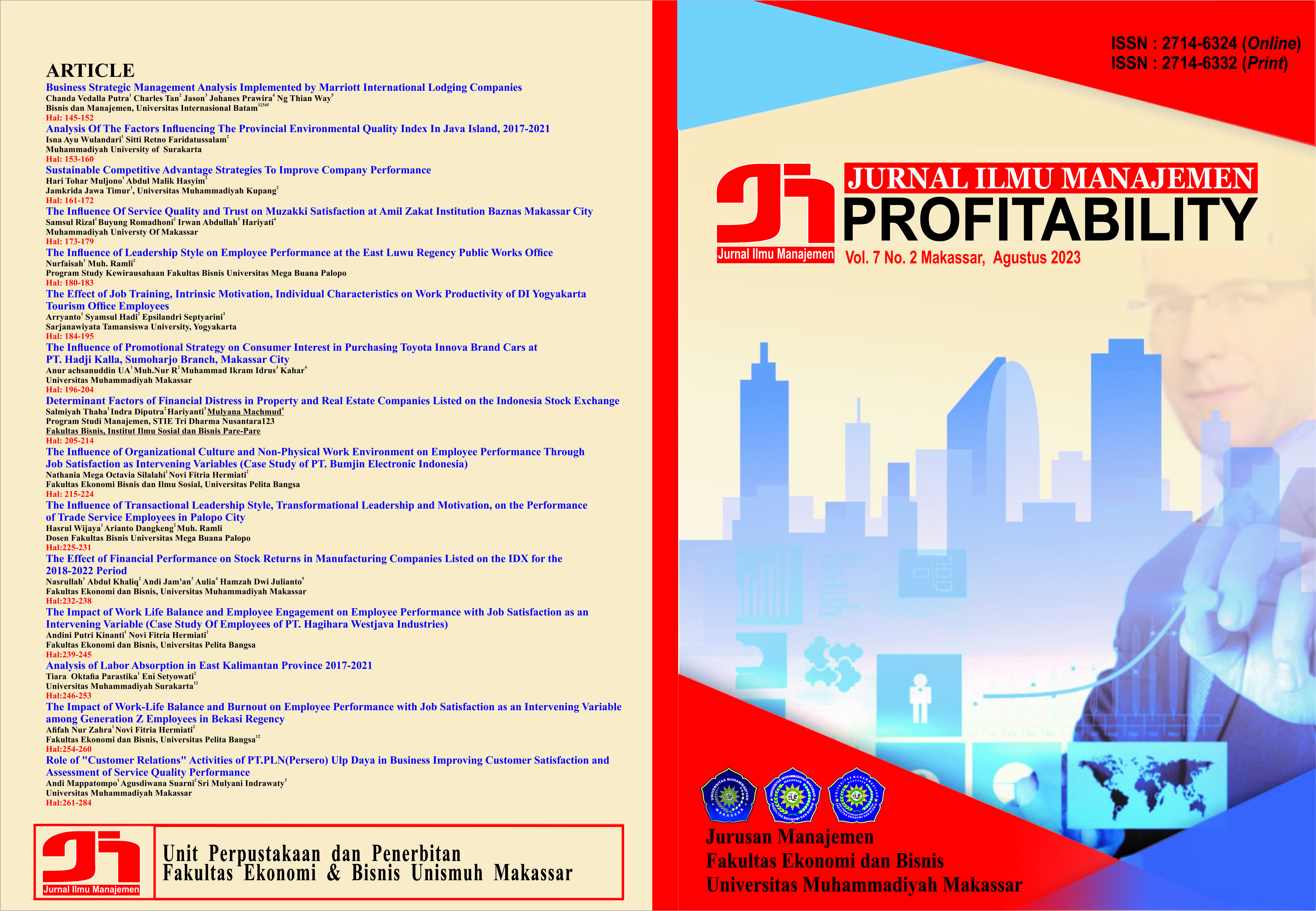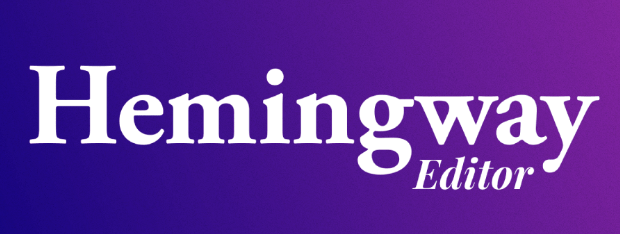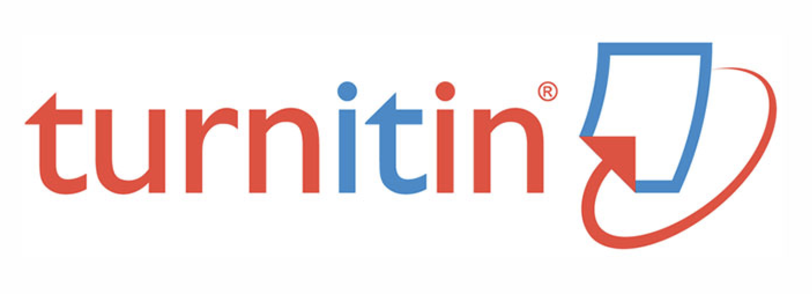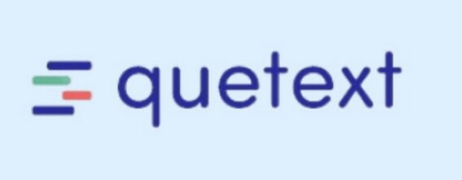Strategies for Achieving Sustainable Competitive Advantage to Enhance Company Performance
DOI: https://doi.org/10.26618/profitability.v7i2.11944
Business Strategy, Sustainable Competitive Advantage, Company Performance
Abstract
This study outlines a sustainable competitive advantage strategy aimed at enhancing company performance. Contingency theory is employed to elucidate strategies linked to the external business environment, thereby determining company performance. Additionally, the Resource-Based View (RBV) theory expounds upon the resources possessed by companies, with the intention of bolstering company performance within the context of a highly competitive global business landscape. The method employed in this study involves the utilization of library research methodology (library research). The findings of this study underscore that the strategy employed encompasses a business approach enabling companies to attain sustainable competitive advantage. This encompasses various facets such as the strategy type, strategic mission, and strategic positioning. Fundamentally, a sustainable competitive advantage strategy in business necessitates the identification of opportunities and an ongoing commitment to innovation to differentiate the company from its peers and mitigate imitation risks. Continuous innovation serves as a catalyst towards ultimately achieving a sustainable competitive advantage. Furthermore, the company undertakes a diversification strategy to heighten corporate value. Through diversification, the anticipation is for the company to yield increased profitability.References
Adel, H. M., Zeinhom, G. A., & Younis, R. A. A. (2021). From university social-responsibility to social-innovation strategy for quality accreditation and sustainable competitive advantage during COVID-19 pandemic. Journal of Humanities and Applied Social Sciences. https://doi.org/10.1108/jhass-04-2021-0086
Ahmad, A. (2015). Business intelligence for sustainable competitive advantage. Advances in Business Marketing and Purchasing, 22A, 3–220. https://doi.org/10.1108/S1069- 096420150000022014
Amiruddin, R., Majid, A. A., & Maelah, R. (2013). Linking business strategy to management accounting : A study in Malaysian service organizations Linking Business Strategy to Management Accounting : A Study in Malaysian Service Organizations. January.
Amoako, G. K. (2020). A conceptual framework: Corporate environmental management activities and sustainable competitive advantage. Management of Environmental Quality: An International Journal, 31(2), 331–347. https://doi.org/10.1108/MEQ-09-2019-0187
Arsawan, I. W. E., Koval, V., Rajiani, I., Rustiarini, N. W., Supartha, W. G., & Suryantini, N.
P. S. (2022). Leveraging knowledge sharing and innovation culture into SMEs sustainable competitive advantage. International Journal of Productivity and Performance Management, 71(2), 405–428. https://doi.org/10.1108/IJPPM-04-2020-0192
Cescon, F., Costantini, A., & Grassetti, L. (2019). Strategic choices and strategic management accounting in large manufacturing firms. In Journal of Management and Governance (Vol. 23, Issue 3). Springer US. https://doi.org/10.1007/s10997-018-9431-y
Chaharbaghi, K., & Lynch, R. (1999). Management Decision Sustainable competitive advantage: towards a dynamic resource-based strategy Sustainable competitive advantage: towards a dynamic resource-based strategy. In Management Decision Journal of European Industrial Training Management Decision Iss Management Decision (Vol. 37354, Issue 371, pp. 45–50). http://dx.doi.org/10.1108/00251749910252012%5Cnhttp://%5Cnhttp://dx.doi.org/10.11 08/MD-05-2012-0392
Cinquini, L., & Tenucci, A. (2010). Strategic management accounting and business strategy: A loose coupling? Journal of Accounting & Organizational Change, 6(2), 228–259. https://doi.org/10.1108/18325911011048772
Citrayantie, T., Said, D., & Mediaty. (2020). Green Accounting in Paper Review. Jurnal Akuntansi , Kewirausahaan Dan Bisnis, 5(1), 1–11.
Cui, Y., & Jiao, H. (2011). Dynamic capabilities, strategic stakeholder alliances and sustainable competitive advantage: Evidence from China. Corporate Governance, 11(4), 386–398. https://doi.org/10.1108/14720701111159235
Damayanti, F., & Adiwibowo, L. (2021). Analisis VRIO Model Perusahaan Fintech dalam Menciptakan Keunggulan Kompetitif Berkelanjutan. V(2), 124–133.
Donaldson, L. (2015). Structural Contingency Theory. In International Encyclopedia of the Social & Behavioral Sciences: Second Edition (Second Edi, Vol. 23). Elsevier. https://doi.org/10.1016/B978-0-08-097086-8.73110-2
Harahap, Nursapia, I.-S. M. (2014). Penelitian Kepustakaan. 08 No. 01, 69–73.
Haseeb, M., Hussain, H. I., Kot, S., Androniceanu, A., & Jermsittiparsert, K. (2019). Role of social and technological challenges in achieving a sustainable competitive advantage and sustainable business performance. Sustainability (Switzerland), 11(14). https://doi.org/10.3390/su11143811
Hatimah, H., Ludigdo, U., & Achsin, M. (2019). Epistemologi islam sebagai metodologi penelitian. IMANENSI: Jurnal Ekonomi, Manajemen Dan Akuntansi Islam, 2(2), 1–6. https://doi.org/10.34202/imanensi.2.2.2017.1-6
Hertati, Lesi and Safkaur, O. (2019). Impact of Business Strategy on the Management Accounting: The Case of the Production of State-Owned Enterprises in Indonesia, South Sumatra. Journal of Asian Business Strategy, 9(1), 29–39. https://doi.org/10.18488/journal.1006.2019.91.29.39
Heywood, C., & Kenley, R. (2008). Evaluating the sustainable competitive advantage model for corporate real estate. Journal of Corporate Real Estate, 10(3), 160–182. https://doi.org/10.1108/14630010810922067
Ho, K. L. P., Nguyen, C. N., Adhikari, R., Miles, M. P., & Bonney, L. (2018). Exploring market orientation, innovation, and financial performance in agricultural value chains in emerging economies. Journal of Innovation and Knowledge, 3(3), 154–163. https://doi.org/10.1016/j.jik.2017.03.008
Hossain, M. S., Hussain, K., Kannan, S., & Kunju Raman Nair, S. K. (2022). Determinants of sustainable competitive advantage from resource-based view: implications for hotel industry. Journal of Hospitality and Tourism Insights, 5(1), 79–98. https://doi.org/10.1108/JHTI-08-2020-0152
Jeklin, A. (2016). 済無No Title No Title No Title (Issue July).
Jogaratnam, G. (2017). How organizational culture influences market orientation and business performance in the restaurant industry. Journal of Hospitality and Tourism Management, 31, 211–219. https://doi.org/10.1016/j.jhtm.2017.03.002
Johannessen, J. A., & Olsen, B. (2009). Systemic knowledge processes, innovation and sustainable competitive advantages. Kybernetes, 38(3–4), 559–580. https://doi.org/10.1108/03684920910944795
Joroff, M., Lourgand, M., & Lambert, S. (1993). Strategic Management of the Fifth Resource: Corporate Real Estate. IDRC, Atlanta, GA.
Khan, S. Z., Yang, Q., & Waheed, A. (2019). Investment in intangible resources and capabilities spurs sustainable competitive advantage and firm performance. Corporate Social Responsibility and Environmental Management, 26(2), 285–295. https://doi.org/10.1002/csr.1678
Khandekar, A., & Sharma, A. (2005). Managing human resource capabilities for sustainable competitive advantage: An empirical analysis from Indian global organisations. Education and Training, 47(8–9), 628–639. https://doi.org/10.1108/00400910510633161 Kiyarsi, R., & Bharata, R. W. (2021). Based on the Library Research Method. 4(November),66–74.
Kuncoro, W., & Suriani, W. O. (2018). Achieving sustainable competitive advantage through product innovation and market driving. Asia Pacific Management Review, 23(3), 186– 192. https://doi.org/10.1016/j.apmrv.2017.07.006
Lee, J., & Miller, D. (1996). Strategy, Environment and Performance in Two Technological Contexts: Contingency Theory in Korea. The SAGE Dictionary of Qualitative Management Research, 17/5, 729–750. https://doi.org/10.4135/9780857020109.n25
Nurkhin, A., Wahyudin, A., & Fajriah Aenul Septiani, A. (2017). Nilai Perusahaan Barang Konsumsi. Jurnal Akuntansi Multiparadigma JAMAL, 8(1), 1–227.
Olazo, D. B. (2022). Marketing competency, marketing innovation and sustainable competitive advantage of small and medium enterprises (SMEs): a mixed-method analysis. Asia Pacific Journal of Marketing and Logistics, ahead-of-p(ahead-of-print). https://doi.org/10.1108/APJML-01-2022-0050
Porter, M. E. (1996). What is Strategy? Havard Business Review, November-December, 37– 55. https://doi.org/10.1057/9780230378117_2
Porter, M. E. (2012). Competitive Strategy: Techniques for Analyzing Industries and Competitors. Revista Inteligência Competitiva, 2(2 SE-Dicas). https://doi.org/10.24883/IberoamericanIC.v2i2.38
Pratono, A. H. (2022). Reinterpreting excellence for sustainable competitive advantage: the role of entrepreneurial culture under information technological turbulence. Measuring Business Excellence, 26(2), 180–196. https://doi.org/10.1108/MBE-04-2021-0056
Pratono, A. H., Darmasetiawan, N. K., Yudiarso, A., & Jeong, B. G. (2019). Achieving sustainable competitive advantage through green entrepreneurial orientation and market orientation: The role of inter-organizational learning. Bottom Line, 32(1), 2–15. https://doi.org/10.1108/BL-10-2018-0045
Quaye, D., & Mensah, I. (2019). Marketing innovation and sustainable competitive advantage of manufacturing SMEs in Ghana. Management Decision, 57(7), 1535–1553. https://doi.org/10.1108/MD-08-2017-0784
Rijamampianina, R., February, Y., & Abratt, R. (2003). A framework for concentric diversification through sustainable competitive advantage. Management Decision, 41(4), 362–371. https://doi.org/10.1108/00251740310468031
Sari, K. P., S, N., & Irdamurni, I. (2020). Pengembangan Kreativitas Dan Konsep Diri Anak Sd. Jurnal Ilmiah Pendidikan Dasar, 7(1), 44. https://doi.org/10.30659/pendas.7.1.44-50
Sawarjuwono, Fauzia, dan W. (n.d.). Implementasi Etika Transenden Berbasis Tauhid pada Kode Etik Akuntan: Sebuah Pemikiran.
Singh, V., Vaibhav, S., & Sharma, S. K. (2018). Using structural equation modelling to assess the sustainable competitive advantages provided by the low-cost carrier model: The case of Indian airlines. Journal of Indian Business Research, 13(1), 43–77. https://doi.org/10.1108/JIBR-12-2017-0260
Teoh, B. A., Teoh, P. C., Tan, H. C., & Ibrahim, A. (2021). What is next for sustainable competitive advantages in pandemic outbreak context? International Journal of Productivity and Performance Management, ahead-of-p(ahead-of-print). https://doi.org/10.1108/IJPPM-06-2021-0336
Turner, M. J., Way, S. A., Hodari, D., & Witteman, W. (2017). Hotel property performance: The role of strategic management accounting. International Journal of Hospitality Management, 63, 33–43. https://doi.org/10.1016/j.ijhm.2017.02.001
Wang, W., Zhang, D., Wang, H., Zhu, Q., & Morabbi Heravi, H. (2022). How do businesses achieve sustainable success and gain a competitive advantage in the green era? Kybernetes, ahead-of-p(ahead-of-print). https://doi.org/10.1108/K-07-2021-0614
Yang, M., Wang, J., & Yang, J. (2021). Boundary-spanning search, knowledge integration capability and sustainable competitive advantage. Baltic Journal of Management, 16(3), 446–464. https://doi.org/10.1108/BJM-08-2020-0314
Downloads
Published
Issue
Section
License
Authors who publish with Jurnal Ilmu Manajemen Profitability agree to the following terms:
Copyright of the articles remains with the authors.
Authors grant the journal the right of first publication with the work simultaneously licensed under a Creative Commons Attribution-NonCommercial 4.0 International License (CC BY-NC 4.0). This license allows others to:
Share (copy and redistribute the material in any medium or format)
Adapt (remix, transform, and build upon the material)
as long as they give appropriate credit to the original author(s) and source, provide a link to the license, and indicate if changes were made. Non-commercial use only.
Authors are permitted to:
Distribute their published work (e.g., post it to an institutional repository or publish it in a book), with an acknowledgment of its initial publication in this journal.
Enter into separate, additional contractual arrangements for the non-exclusive distribution of the journal’s published version of the work (e.g., post it to a class website or institutional archive).
For permissions to use the content published in this journal beyond the scope of the license (e.g., commercial purposes), please contact the editorial office via the journal email.
License Details:
This journal is licensed under a Creative Commons Attribution-NonCommercial 4.0 International License (CC BY-NC 4.0).












